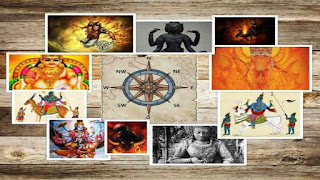Guardians of the directions
In Hindu culture the Disha or Dik means Direction. As per hindu science there are mainly 10 directions surrounding the universe. But if you go into deep, you will experience that infinite directions have been mentioned in ancient hindu science. Some scholars have linked these directions to various dimensions, but there is no need to comment on their significance at the moment. The 10 directions are as follows, East, South-East (Agneya), West, North-West (Vayavya), North, North-East (Isanya), South, South-West (Nauritya), Zenith (Urdhva), Nadir (Adho). In both Hinduism and Buddhism, every direction is considered to be regulated by the different guardians. Each direction is controlled by different deities with their own cosmic powers. Now one thing you have to understand that neither direction can be situated on a straight line. Each of these direction covers a vast area of the space, and if you think about it deeply, this vast cosmic area is literally infinitely wide. These infinitely vast cosmic regions have been referred to as the cosmic kingdoms or dimensions or Loka in various ancient Hindu texts. According to Hindu mythology, the entire universe consists of 14 primary lokas or dimensions. The guardians of every Loka are named by a special designation, termed Palas. The Palas are divided into principal classes dikpalas and lokapalas.
Dikpala
Dikpalas are the guardians deities of the 10 directions. They are governing their specific directions. Each direction has its own merits. There is an unidentifiable influence behind every event that happens on this earth. Again, according to the ancient Indian Vastu Shastra, the role of directions play an important role behind the construction of any architecture or building. Among many other sciences, originated in ancient India, Vastu Shastra is one of the most complex and important subject. We need to discuss some common concepts about the nature of directions. The value of the internal angle of a field is 360 degrees. For example we can imagine a compass. The internal angle of the compass is 360 degrees. Compass has a total radius of 360 degrees. Every direction is assigned 45 degrees. In any direction, measuring the level of degree is very essential. As per vedic astrology the guardians of the directions govern their allocated direction through some stars and planets. Again, The theory of Vastu relies on the organization and re- configurations of the 5 elements: earth, water , fire , air and sky to deliver the best possible results. These factors form the basis on which the concepts of architecture have been developed and attributed.
The influence of the Indian religion culture can be seen in how their temple entrances are guarded. There are different kind of statues that guard the different cardinal points, or orientation. Specially in Southeast Asia, in places like India, Java, Bali, China and Sri Lanka. We know Buddhism originated in Hinduism, there are some similarities between these two faiths. One is the importance of posting guards at the entrances, which are oriented according to the Cardinal Points. The In Hinduism beside the four points for orientation, in India there are actually eight points, and at times two more points directions are added, for a total of ten orientation points. When referring to the eight guardian deities, the word is Asta-Dikpala, at times two extra directions are added, to have ten directions, but when added the two extra direction points, then these guards deities are called Dasa-Dikpala, meaning ten direction points guards. The images of these deities can be seen on the roofs and walls of the temples they guard. In other nearby places, like Java and Bali, only nine guardians of directions are recognized, and then word for these nine deities is Nava Dikpala.
Lokpala
Beside the Dikpala deities guarding the temple entrances, there are other kinds of guards, for a different purpose and different areas. These other deities guards are called Lokapalas, and guard nine different Lockas. Kubera is the Lokapala that holds a mace, and guards the north. The Buddhist Lokpalas are. Dhrtarastra, and guards the East. Virupaksa, guards the West. Vaisravana guards North. and Virudhaka guards the South. With these Lokapalas with Lord Brahma and Lord Vishnu too. In Tibetan Buddhism many of these worldly protector deities are indigenous Tibetan deities, mountain gods, demons, spirits or ghosts that have been subjugated by Padmasambhava or other great adepts and oath bound to protect a monastery, geographic region, particular tradition or as guardians of Buddhism in general.
The names of the Dikpalas differ somewhat, but usually include the following:
1. Kubera the deity of wealth governs the north. His weapon is gada, consort is Bhadra and representing planet is Budha or Mercury.
2. The Yama god of death governs south. His weapon is Pasam or cosmic rope of death, representing planet is Mars.
3. The Indra governs east. His weapon is Thunder, Representing star is Sun.
4. The Varuna god of water governs wast. His weapon is Pasa/noose, representing star is Saturn.
5. The Ishana or Shiva governs northeast. His weapon is Trisula, representing star is Jupiter.
6. The Agni the god of fire or energy governs southeast. His weapon is Danda or staff, representing star is Venus.
7. The Vayu the god of wind governs northwest. His weapon is Ankusha, representing star is Moon.
8. The Nirrti governs southwest. His weapon is sword, representing star is Rahu.
9. The Brahmha governs zenith. His weapon is Bramhasira, representing star is Ketu.
10. The Vishnu governs nadir. His weapon is Chakra, representing star is Lagna.

No comments:
Post a Comment
Please do not enter any spam link in the comment box. Thanks for reading our articles.